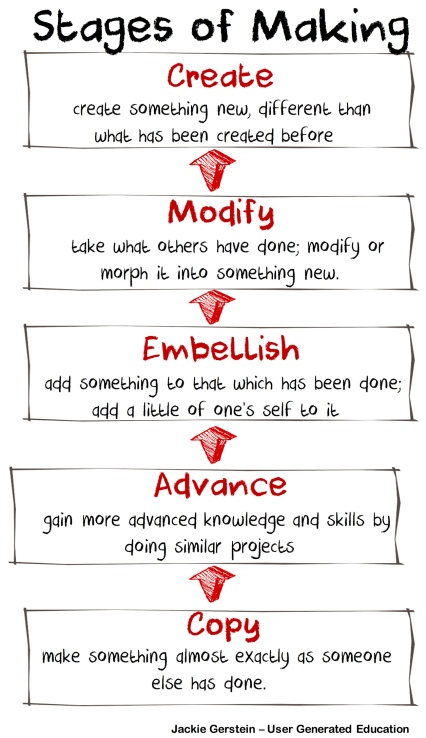Scaffolding Maker Education Learning Experiences
I often read via social media about the importance of student centered, student-driven instruction. I wholeheartedly agree. My blog post is called User-Generated Education for a reason. I also believe one of the roles of an educator, in the context of maker education, is to scaffold learning experiences so the end result is students becoming self-determined learning.
Thinking about the importance of learner autonomy and independence reminded me of my early career when I did counseling work with at-risk youth in wilderness settings, taking them on 2 to 3 week wilderness trips. We did what was called Huddle-Up Circles. Huddle-ups were called by the instructors and/or the youth participants any time a concern or problem arose. Everyone stopped what they were doing to gather in a circle to discuss the problem and generate solutions. Needless to say, the instructors were the ones who most often called and facilitated the huddle-ups at beginning of our trips. Our goal, as instructors and counselors, was to have the young people run the huddle-ups themselves. We knew we were successful when we asked to step out of the huddle-ups by the young people because they wanted to run their own huddle-ups. During these times, we would stand outside of the huddle-up circles and silently observe their processes, only stepping in upon their request. The results not only included the development of skills and strategies for their own social-emotional development, but their success with their earned independence boosted their self-esteems.
This is how I approach facilitating maker education activities. Direct instruction is provided through structured and prescribed activities with the goal of learners then being able to eventually go into self-determined directions. There has been some criticism leveraged against out-of-the-box maker education kits, programmable robots, and step-by-step maker activities. My contention is that learners often don’t know what they don’t know; and that giving them the basic skills frees them to then use their creativity and innovation to take these tools into self-determined directions.
In response, I created and proposed Stages of Maker Education:

In my robotics and coding classes, I use Ozobot, Spheros, Dash and Dot, microbits, Scratch, to name of few. I use a full spectrum of activities starting with direct instruction associated with the Copying stage, then assisting learners to move through the Advance, Modify, and Embellish stages by providing them with examples and resources, and finally, encouraging them to move into the Create stage. Sometimes I show them examples of possibilities for the Create stage. I show such examples to spark and ignite their creative juices. Because almost all of my learners have not had the freedom to create, these examples help to get them motivated and going. Here some are examples of two ends of the spectrum – Prescribed/Copy and Create – of some of these robotic and coding activities to show how learning basic skills can lead to creative activities:
- Ozobot:
- Prescribed/Copy – Ozobot Basic Training
- Create – for creative use of Ozobot examples see https://youtu.be/2C-jbsfBJvA and https://youtu.be/OtUXrVGW3r0 (One of my groups of gifted students are currently working on their own projects to tell a story with Ozobot. I will add their stories once they are completed.)
- Dash and Dot:
- Prescribed/Copy – Teacher-driven lessons found at https://education.makewonder.com/curriculum/learn-to-code
- Create -for examples of the creative use of Dash, see Creativity Corner found at https://www.makewonder.com/play/ideas/
- Scratch:
- Prescribed/Copy – Using Scratch Cards and/or doing Scratch Starter Projects
- Create – for creative examples of Scratch, see https://scratch.mit.edu/studios/232765/
- Sphero:
- Prescribed/Copy – beginning coding activities found at https://edu.sphero.com/cwists/category
- Create – for ways that Sphero creatively for cross-curricular activities, see http://stemeducationguide.com/classroom-activities-sphero/
- micro:bit:
- Prescribed/Copy – step-by-step projects found at https://makecode.microbit.org/# and https://makecode.microbit.org/projects
- Create – for examples of creative projects using micro:bits, see http://microbit.org/en/2017-04-12-mothers-challenge-winners/
My ultimate goal is to have students drive their own learning and I want to help them learn skills to be successful in their self-determined learning.

I do like the sound of the “huddle ups” and agree with the importance of learners being autonomous.
Norah Colvin
November 20, 2017 at 10:37 am
Dr. Gerstein, you state, “Direct instruction is provided through structured and prescribed activities with the goal of learners then being able to eventually go into self-determined directions.” Do you use Creative Problem Solving (CPS) to help students open their minds to innovation and creativity? Such as having them ask “What else?” (could this look like, etc.) 5x during the “Copy Stage”.
Annie Kling
November 27, 2017 at 2:23 pm
Hi Annie – I do warm-ups with my students to get their creative juices flowing – see https://usergeneratededucation.wordpress.com/2017/08/20/intentional-creativity/
Jackie Gerstein, Ed.D.
November 28, 2017 at 12:55 am
Dr. Gerstein, Thank you for your reply and the link. I am very interested in how individual educators teach, their methodology, insights, etc. I am a Ph.D. student (Education-Learning, Instruction & Innovation) and I want to make sure that when I design learning environments that I never forget the educator’s viewpoints or expertise. I don’t want to become one of those designers that designs for the system.
Again, Thank you for sharing your knowledge with me.
Annie
Annie Kling
November 29, 2017 at 3:18 pm